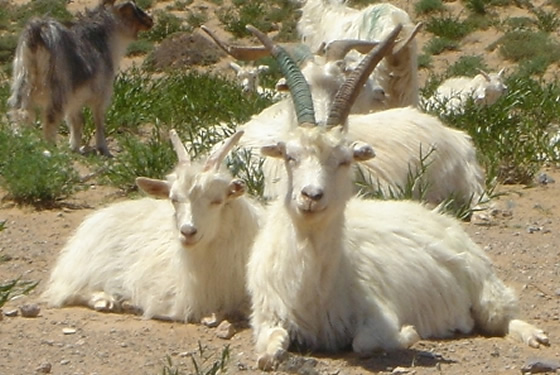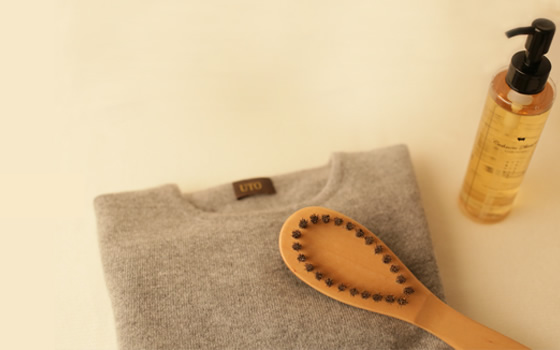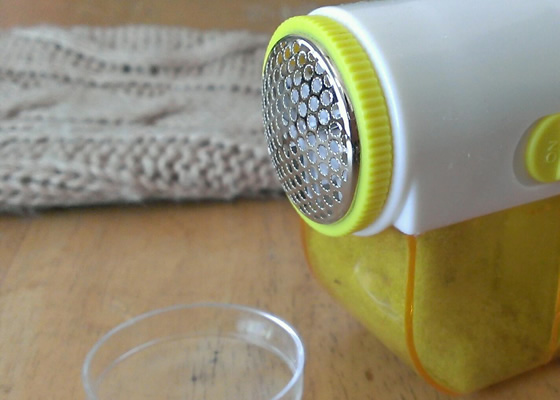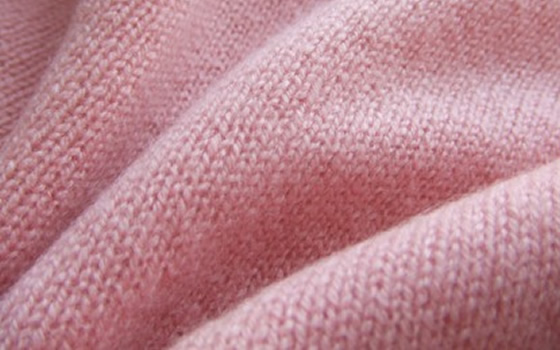Prevention of pilling in cashmere knits
Pilling is called "pilling" in the industry.
Some people have the misconception that "cheap cashmere will pill, and expensive cashmere will not." However, this does not mean that some cashmere can pill and others cannot.
Basically, all wool materials, not just cashmere, pill.
Cashmere knits are something you want to take good care of, so if you learn about the mechanism by which pilling occurs and wear it based on that knowledge, you will be able to wear it more comfortably without pilling.

Causes of hairballs
There are two main reasons why hairballs form.
They are " friction " and " entanglement ".
"Pilling" is a state in which the fibers in the parts that are not twisted into the yarn (pile feet) are entangled with each other, forming a ball as the name suggests.
The fibers that come out from the twisting of this thread are what gives cashmere its fluffy and soft feel.
"Foreign objects" and "static electricity"
The source of pill formation is called the "pill nucleus," and most of the triggers are foreign objects or static electricity.
Foreign objects are not only those that are visible to the naked eye, but also objects such as broken fabrics such as jackets, and particles floating in the air that can cause "pill nuclei" to form. This will cause it.
Also, the static electricity that occurs in the winter causes the fibers to stick together, which can cause them to become tangled.
"humidity" and "heat"
This "humidity" and "heat" are the main points that cause pilling.
In the pilling test, the speed at which the fibers raised by rubbing become entangled is that when rubbing normally at room temperature, the pill grows like a gradual addition, but when moisture or water is applied, the pill grows rapidly like a multiplication. When it grows and heat, especially heat above body temperature, is added to it, the pilling speed becomes even faster.
Why does water and humidity have such an impact?
This is because the cuticles of each wool fiber open when exposed to water or high humidity, making them more likely to get tangled.
Ease of pilling depending on the material
Pilling test "Pilling test"
There is a third-party hair product inspection association called JWIF (JWIF), commonly referred to as hair inspection in the industry.
Here, we conduct a test called the "Pilling Test" to measure the ease with which pilling occurs.We put multiple knitted fabrics in a cork-lined box and rub them together for a certain period of time ( 5 hours) to see how much they pill. The degree of pill formation is determined from grade 1 to grade 5 . ( The larger the number, the less likely pilling will occur )
In the case of UTO 's cashmere products, they are grade 3 to 4 in the pilling test ( ICI ), and cashmere is generally grade 2, so this is not a problem at all as a product.
Ease of pilling of each animal hair fiber
Natural wool's fibers are curly and tend to roll up easily.
Because of this crimp, you can create a fluffy yarn that is resistant to tension without having to twist it so tightly when spinning.
By curling up and trapping air to increase heat retention, it plays an important role in protecting you from the outside air.
This crimp also has its own characteristics depending on each animal, and some types are more prone to pilling and others are less likely to do so.
The order in which common animal hair fibers tend to pill (shrinkage) is as follows:
★Angora > Rum > Cashmere > Camel > Mohair > Alpaca
Among animal hairs, angora is the most prone to pilling, alpaca is relatively less prone to pilling, and cashmere is somewhere in between.
Also, the fibers of alpaca, which are less likely to pill, tend to be straight and do not have many crimps, so they tend to fall out before pilling.
However, this is just a characteristic of the fiber, and it varies considerably depending on how the product is made and how it is worn.

Measures against pilling
1. Reduce friction
Wearing a sweater can be said to cause friction.
Therefore, although it is not possible to eliminate friction, it is possible to reduce the degree of friction.
For example, it is recommended to avoid the following cases:
When you wear it as a jacket, the friction is mainly from your own arms, but there have been cases where the back has rubbed against the wool seats of cars and other cars, causing pilling.
What I don't really notice is the jacket when layered over a sweater.
In particular, unlined tweed jackets have strong friction and are prone to pilling.
In addition, when a bag made of canvas products rubs against it, pilling may occur only in the area that the bag touched.

2. Measures against foreign objects and static electricity
Pills can be caused by fibers getting tangled on their own, or by foreign objects or static electricity causing fibers to stick together and become tangled.
When we say foreign matter, it is more like minute pieces of fiber than visible dirt. Frequent brushing is the best way to get rid of these hairballs.
Just a little brushing before putting it on and putting it away makes a big difference.
I will untie the pill nucleus that is about to get tangled.

3. Measures against stuffiness (humidity/temperature)
You also need to be careful about how often you wear them and when doing strenuous exercise.
Especially men, some people wear the same clothes for several days in a row, so be careful.
For example, if you drive a car wearing a sweater inside a jacket, the part of your body that was held down by the seatbelt will become pilled within 4 to 5 days.
There have been cases where people have worn it inside a windbreaker and played golf all day and ended up with pilling in their armpits.
These are typical examples of continuous wear, stuffiness, pressure and chafing.
Be careful not to get stuffy.
UTO doesn't want you to wear a sweater every day, even if you like it.
・After wearing it for one day, let it rest for about two days to allow time for the moisture accumulated in the fur to release. ・Brush and tame any tangled fur.
How to deal with hairballs that have formed
The source of pilling is tangles of hair fibers, so the only thing you can do is untangle or remove them.
Recommended method for removing hairballs
If a pill forms, it is best to cut it off with scissors without pulling it.
However, if you are not careful, you may end up cutting the body of the sweater (I have also tried and made the mistake of cutting this).
These days, ``easy pill removers'' that are similar to shaving have been released.
If you carefully stroke the surface with a pill remover, it will come off fairly cleanly, so it is safe and recommended.

Will my sweater become thinner if I remove the pill?
Some people are worried that removing the pilling will make the sweater thinner, but as long as you remove the pilling from the surface, there is no problem.
brushing
The source of pilling is tangles of hair fibers, so the only thing you can do is untangle or remove them.
To remove tangles, comb or brush with a ``soft-bristled brush'' (brushes specifically made for cashmere are also available commercially).
[Aside] Cashmere does not pill
When I first heard this, I was surprised and thought, "Wow! That's possible," but now I'm more like, "Wow!"
But it's an amazing technique.
"Preshrunk yarn" with scientific processing
This is a microscopic world seen through a microscope, and as I mentioned earlier, the cuticles of wool fibers open and become easily tangled in wet or humid conditions. It involves removing it or wrapping the cuticle in a membrane.
In the industry, it is called ``preshrunk yarn,'' but it seems like many of the sweaters that have been distributed in large quantities in recent years are made of preshrunk yarn.

Normally, the wool fibers breathe, making it dry when it's humid and moist and comfortable when it's dry, but the unique qualities of wool are lost.
On the other hand, it doesn't shrink or pill even if you wash it a little hard.
There is no doubt that the material is 100% wool/100% cashmere, but personally, I personally feel that a sweater with this kind of processing feels soft, but somehow lacks elasticity.
Smooth wool doesn't have a fluffy feel and is unreliable, like castrated wool, so I have no plans to use it as a UTO.
However, I think that shrink-proof yarn is useful when supplying woolen sweaters that can be easily washed by many people.
Are hairballs more likely to form in the beginning?
This is a story from my own experience as I love cashmere and wear cashmere sweaters most of the winter.
From my experience of wearing cashmere for over 30 years, I have found that cashmere pilling is most likely to occur when you first purchase it, and if you use a pill remover to remove it each time it occurs, it will gradually become less noticeable. There are many.
There are some that don't pill at all, and some that are easy to pill.
If you remove items that tend to pill as often as possible during the first year, they will gradually become less pillable in the second and third years.
It's a shame that we can't just casually say, ``You'll no longer be able to do it eventually,'' as there hasn't been any detailed scientific research and this is just a rule of thumb.






